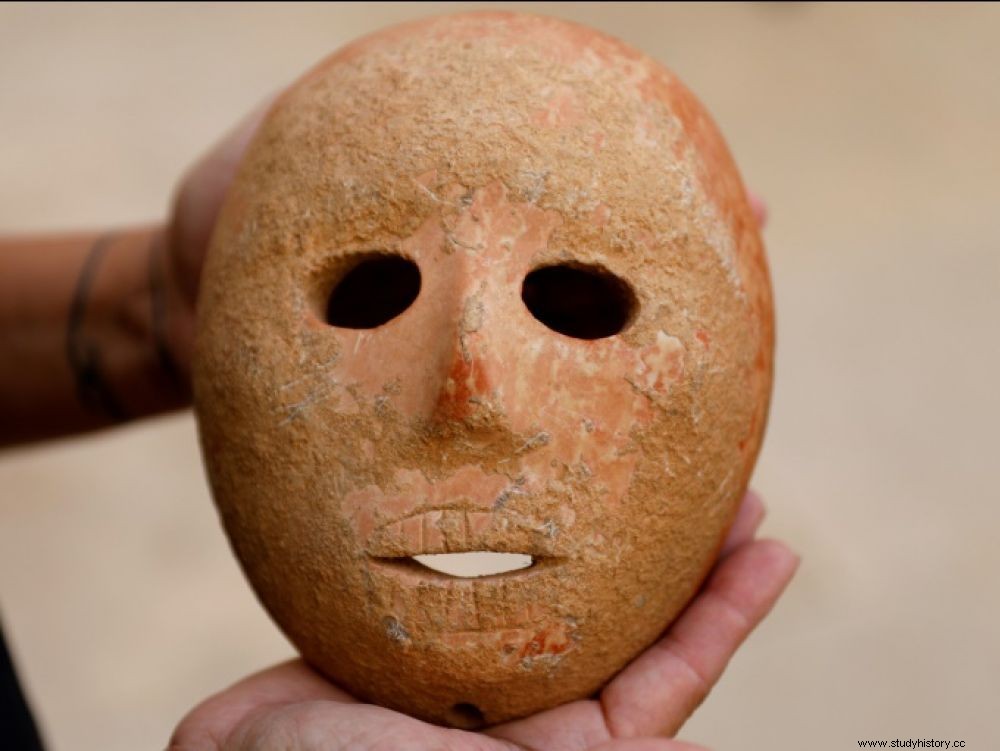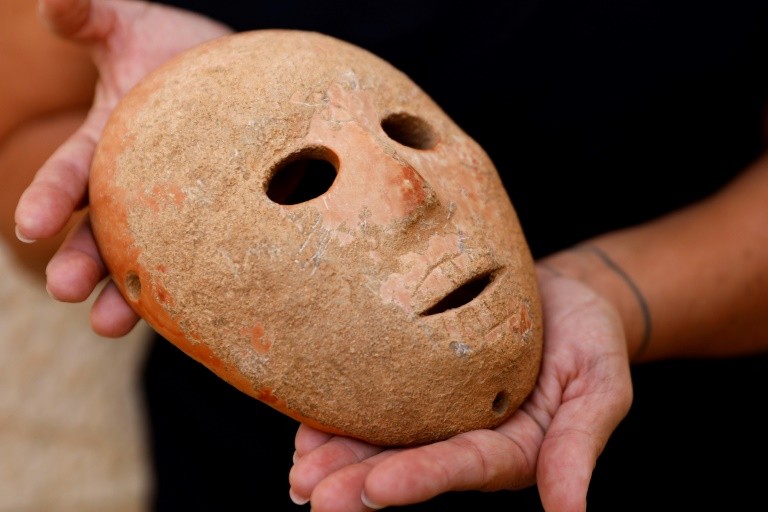The Israeli Archaeological Authority presented Wednesday, November 28, 2018 in Jerusalem a rare stone mask about nine thousand years old and associated with the development of ancestor worship coinciding with the sedentarization of men.

The Israeli Archaeological Authority presents on November 28, 2018 in Jerusalem a rare stone mask about nine thousand years old.
The Israeli archaeological authority remained vague on the circumstances of this discovery which dates back, according to it, to several months. A stone mask said to come from near the Israeli settlement of Pnei Hever in the West Bank. An object dated to around 9,000 years old. The West Bank is a Palestinian territory occupied by Israel for more than fifty years. Disputes between Israelis and Palestinians over ownership of archaeological finds are one aspect of the age-old conflict over land.
The mask, dating back to the early Neolithic (New Stone Age), was discovered by a walker, said Authority archaeologist Ronit Lupu. Israeli authorities were made aware of the mask's existence in early 2018 and traced it to the inventor, who gave it to them, she said. The mask, carved from carefully worked and polished limestone in pink and yellow hues, "is very naturalistic in craftsmanship, you see the cheeks, the nose is perfectly rendered ", Ms. Lupu said. Holes have been created for the eyes and teeth appear in the mouth. "This is a rare mask, the latest one was discovered 35 years ago (... ) But what is special is that we know where it comes from, we know the archaeological context ", Ms. Lupu said.

The Israeli Archaeological Authority presents a rare stone mask about nine thousand years old in Jerusalem on November 28, 2018 ©AFP - GALI TIBBON
There were already about fifteen masks from the same period also from the hills and the Judean desert, the vast majority scattered in private collections around the world. Only two of them have a clearly identified archaeological context. Flint tools discovered on the site where the mask came from made it possible to date it to around 9,000 years ago, at the start of the "agricultural revolution", when men stopped living from hunting and gathering and settled down. , cultivating and domesticating animals.
An exhibition was devoted to these masks in 2014 (exhibition entitled "Face to Face"), at the Israel Museum, in Jerusalem. Discovered a few years ago in the hills of the Judean desert, these twelve masks from the Neolithic period were then brought together in the same exhibition for the first time. Some came from the archaeological excavations carried out by Ofer Bar Yosef in 1983 in the cave of Nahla Hemar, perched in a cliff above the Dead Sea, others from Horvat Douma, near the city of Hebron.
A period of spectacular development of rituals of a spiritual and ancestral nature
Weighing two kilos each, these real petrified faces all represent different faces with various expressions:eye cavities, mouths wide open, some also features that resemble skulls. According to Debby Hershman, a prehistory specialist at the Israel Museum, these carved limestone masks were used in ancestor worship. Those of deceased deceased? Several have perforations all around, indicating that they were definitely meant to be worn. This is also the case of the one that has just been discovered. The latter has holes in the sides and at the top and bottom, perhaps for carrying by an individual, but more likely for display, such as on a pole, Ms. Lupu says. "We believe that this mask belongs to the spiritual world of Neolithic populations ", she says. Traces of pigments have been detected in places, which leads to the idea that these masks were painted.
The period saw a spectacular development of rituals of a spiritual and ancestral nature, attested by the discovery of human-shaped figurines, skulls covered with plaster, and stone masks, said Omry Barzilai, a researcher quoted in a press release from the Authority. Ms. Lupu, questioned by AFP, refrained from giving any details about the identity of the discoverer of the mask and the conditions under which the Archaeological Authority found itself in its possession.
